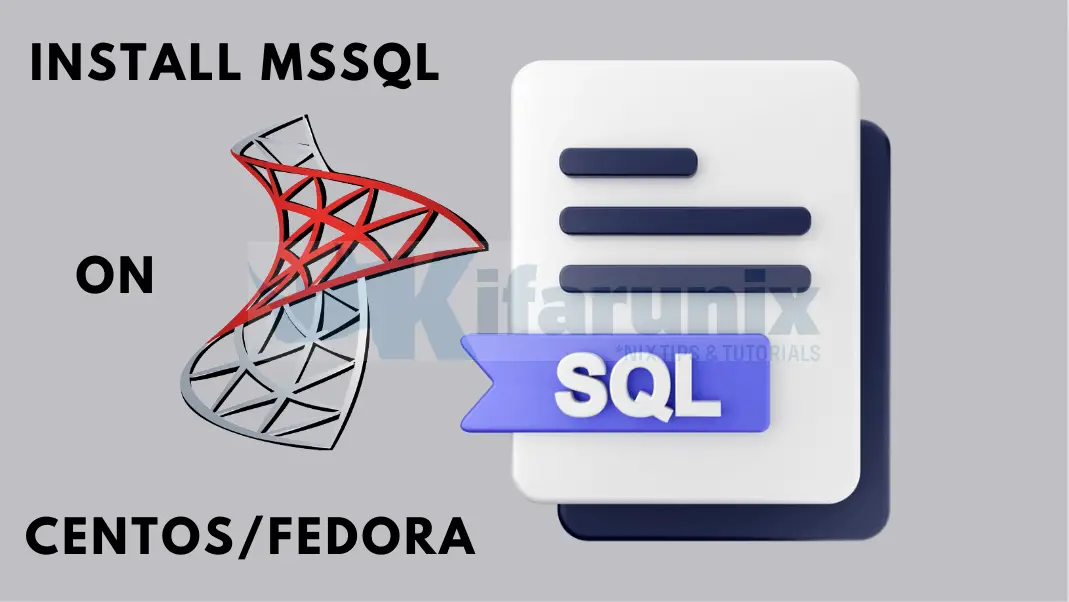
Welcome to our guide on how to install Microsoft SQL server 2017 on Fedora 29/CentOS 7.
Table of Contents
Installing Microsoft SQL Server 2017 on Fedora/CentOS
Prerequisites
Before you can follow through, ensure that your server meets the following minimum requirements;
- At least 2GB of RAM
- 64-bit CPU architecture
- At least 6GB of disk space
- At least 2x2GHZ CPU cores
- EXT4 or XFS filesystem
To install MS SQL server 2017 on Fedora 29/CentOS , you need to create the MS SQL repository on your Fedora 29/CentOS 7 server since mssql-server package is not available on the default repos.
Create MS SQL repository
Run the command below to install Fedora/CentOS MS SQL repo.
wget -O /etc/yum.repos.d/mssql-server-2017.repo https://packages.microsoft.com/config/rhel/7/mssql-server-2017.repo
Install Microsoft SQL Server 2017
Once the MS SQL repository is created, install MS SQL server.
On CentOS 7, run;
yum install mssql-server
On Fedora 29, run;
dnf install mssql-server
You can however use yum on both.
Setup MS SQL server
Once the installation is done, run the setup script, /opt/mssql/bin/sqlservr-setup, to setup MS SQL server system administrator (SA) password and choose your MS SQL edition. You can also choose your server edition using this microsoft sql server software. Note that the Evaluation, Developer and Express editions are free-licensed. In this case, we are going to choose the Developer Edition. All the limitations have been removed on the Developer edition hence it is fully functional.
/opt/mssql/bin/mssql-conf setup
Choose an edition of SQL Server:
1) Evaluation (free, no production use rights, 180-day limit)
2) Developer (free, no production use rights)
3) Express (free)
4) Web (PAID)
5) Standard (PAID)
6) Enterprise (PAID)
7) Enterprise Core (PAID)
8) I bought a license through a retail sales channel and have a product key to enter.
Details about editions can be found at
https://go.microsoft.com/fwlink/?LinkId=852748&clcid=0x409
Use of PAID editions of this software requires separate licensing through a
Microsoft Volume Licensing program.
By choosing a PAID edition, you are verifying that you have the appropriate
number of licenses in place to install and run this software.
Enter your edition(1-8): 2
The license terms for this product can be found in
/usr/share/doc/mssql-server or downloaded from:
https://go.microsoft.com/fwlink/?LinkId=855862&clcid=0x409
The privacy statement can be viewed at:
https://go.microsoft.com/fwlink/?LinkId=853010&clcid=0x409
Do you accept the license terms? [Yes/No]:yes
Enter the SQL Server system administrator password: P@SSWORD12
Confirm the SQL Server system administrator password: P@SSWORD12
Configuring SQL Server...
ForceFlush is enabled for this instance.
ForceFlush feature is enabled for log durability.
Created symlink from /etc/systemd/system/multi-user.target.wants/mssql-server.service to /usr/lib/systemd/system/mssql-server.service.
Setup has completed successfully. SQL Server is now starting.
MSSQL Server Service
MS SQL setup is done. It is now running and has been automatically enabled to start on system reboot.
systemctl status mssql-server● mssql-server.service - Microsoft SQL Server Database Engine
Loaded: loaded (/usr/lib/systemd/system/mssql-server.service; enabled; vendor preset: disabled)
Active: active (running) since Wed 2019-01-16 14:48:43 EST; 8min ago
Docs: https://docs.microsoft.com/en-us/sql/linux
Main PID: 3930 (sqlservr)
CGroup: /system.slice/mssql-server.service
├─3930 /opt/mssql/bin/sqlservr
└─3951 /opt/mssql/bin/sqlservr
The service is also enabled to run on system boot;
systemctl is-enabled mssql-serverenabledMSSQL Service Port
The default port for MS SQL is 1433/TCP.
ss -altnp | grep 1433LISTEN 0 128 *:1433 *:* users:(("sqlservr",pid=3951,fd=133))
LISTEN 0 128 :::1433 :::* users:(("sqlservr",pid=3951,fd=138))
Open MSSQL Service Port on Firewall
Configure firewalld to allow external access to MS SQL server.
firewall-cmd --add-port=1433/tcp --permanent firewall-cmd --reload
Administering MSSQL Server
MS SQL has been successfully installed on Fedora 29/CentOS 7 server.
Install MS SQL server command line management tools
In order to manage the database tasks, you need to install MS SQL server command line management tools such as bcp and sqlcmd. These tools are not available on the default Fedora/CentOS repos. Hence create the repository as shown below;
wget -O /etc/yum.repos.d/mssql-tools.repo https://packages.microsoft.com/config/rhel/7/prod.repo
Install MS SQL command line tools
yum install -y mssql-tools unixODBC-devel
The sqlcmd command is installed to /opt/mssql-tools/bin/. To ensure that the command is available on your default PATH environment, create a symbolic to /usr/bin/ as shown below;
ln -s /opt/mssql-tools/bin/sqlcmd /usr/bin/
The sqlcmd is now available under /usr/bin/.
which sqlcmd
/usr/bin/sqlcmdConnecting to MSSQL Server
Connect locally to you MS SQL server as SA and create a sample database;
sqlcmd -S localhost -U SA
You are prompted for password;
Password: <SA password created above>Successful login takes you to sqlcmd prompt, 1>. Note that an sql statement is not executed until you enter GO.
1> CREATE DATABASE testdbA 2> GO 1>
Verify the test database creation.
1> select name from sys.databases 2> go
If you need to learn more on MS SQL statements, look here. We hope this article helps.


you could also open the firewall by using:
firewall-cmd –add-service=mssql –permanent
as it has a configuration in /usr/lib/firewalld/services/mssql.xml
Thanks for the article.
Looking for steps to install SQL Server on Ubuntu.